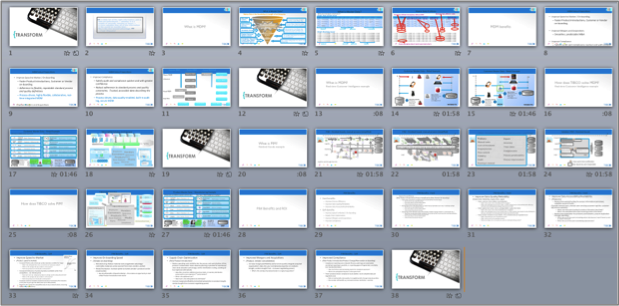The Secret to Presentations that Change Minds

Mahatma Gandhi, Winston Churchill, Martin Luther King Jr., Abraham Lincoln… They all used the same simple tool to influence generations and change the world. Each led his audience to overcome insurmountable obstacles by engaging the heart along with the mind. Many studies bear out the fact that emotion plays a vital role in decision-making. If you want to change minds and influence others, your presentation needs more than facts. From the very start, you need to speak to the emotions.
Emotion or Reason: Which Is More Influential on the Brain?
By Dr. Carmen Simon, founder Memzy
A few months ago, we created a survey asking participants whether it was better to start a presentation by appealing to emotion or reason. Out of the 169 responses, 79% voted in favor of emotion, and 21% chose reason. These statistics show that we tend to place a high value on emotion, at least at the beginning of a presentation.
If we know intuitively that emotion is important in presentations, why don’t we see it included more frequently? You have probably witnessed this situation many times: presenters walking into a business setting, armed with bulletproof facts and irrefutable logic. Audiences listen politely, yet refuse to buy in or change anything.
Why is that? Here are a few answers to consider:
1. Presenters are not aware that scientific research shows a strong link between emotion and decision-making.
Back in 1996, neuroscientist Antonio Damasio studied patients with brain damage in the area of the brain that generates emotions. He observed that even though these patients could not feel emotions, they still performed well on memory, abstract reasoning, and math tasks. However, deprived of emotional markers for every day experiences, these patients were incapable of functioning well, because every option felt as good or bad as any other option. Even small decisions, such as what to eat or what to wear, sent patients into frenzy. In his classic book that became one of the landmarks of contemporary neuroscience, Damasio labeled “Descartes’ error” the idea that human behavior cannot be guided solely by reason.
If you only create informational presentations, appealing to emotion is not a big concern. However, if you create presentations that are meant to persuade, to elicit a behavior/attitude change, or even if you simply want a smooth sales cycle, appealing to emotions is mandatory.
2. Presenters are afraid of “touchy-feely” presentations.
When I encourage presenters to include emotional markers in presentations, the reaction I often get is that they do not want to come across as too “marketing-focused.” Some people would rather not present at all than present emotion-based content. When I ask why, these presenters claim that if they did not rely on logic, they fear they would not appear credible, or someone might think they are too lazy to do their research.
Take a look at the presentations below. Many business presenters would much rather present the slide in Example 1 than the slide in Example 2.
Example 1: Bulletproof data
Example 2: Touchy-feely marketing speak (this can be fixed with a sub-title that alludes to technical information)
The conflict between choosing logic over emotion may be mitigated by understanding a few of the different ways we can trigger emotion in an audience.
- Emotions can be provoked by external stimuli (e.g., lust when you see an attractive potential partner, or anger when you see someone pulling in front of you to steal a parking spot).
- Emotions can also result from internal processes, and it is these kinds that typically lead to changed behavior (e.g., if you’re feeling pain, you will eventually change something to stop the pain).
We can look at emotions as instinctive (e.g., reacting to external beauty); but emotions can also be learned (e.g., someone attending meditation courses to train the brain to be happy). It is this idea of a learned emotion that can provide a revelation for presenters.
You don’t always have to give an audience external stimuli to react to (e.g., a fancy slide with high texture graphics that provoke joy or anxiety). You can teach people, through reasoning elements, how they can feel about something.
Example 3: Marketing-like slides that might make technical presenters cringe
Example 4: Technical slide that displays logical elements and subtly teaches the audience how to feel a level of anxiety regarding their current business processes
In a technical presentation, for example, it may take many slides, filled with logic, to build up to an emotion that the audience is well-served to feel. And the best approach is not to tell them what to feel, but rather to help them discover what feels best. Ultimately, it is self-interest that drives decision-making.
We may feel relief that emotions can be taught, but which emotion is the right one to teach?
3. Presenters don’t always understand the emotional “buttons” to push to drive decisions.
This is especially true since some emotional triggers have been overplayed, and as a result, customers are starting to ignore them or be turned off. For example, fear (“don’t get caught using old equipment”), value (“we will beat the competition’s price”), and trust (“we are a trusted advisor”) have been abused. Some non-abused triggers include:
- Belonging: Most of your audience members are social animals. They often desire to connect with others who have similar interests, and purchase products in an attempt to be part of a social circle. “Join the generation of …” is a strong beginning for these types of audiences.
- Trend-setting. Many audience members want to feel cool or trendy. Presentations that make them feel like they’re first or in control are powerful. Beginnings such as “Be the first on your block” effectively appeal to the emotional trigger of leadership within a field.
- Self-achievement. Most humans have a yearning to improve themselves, to know more, to learn more. They also want others to recognize their intelligence. As you reflect on your presentations, consider how you can help an audience achieve a sense of high-self esteem. A beginning such as “Build confidence when _____” can give audiences a unique kind of high.
Overall, the ability to experience emotions vividly and rapidly helps the audience make effective use of emotion as they reason why they should do business with you.
The answer for an effective presentation opener is not in either logic or emotion, but rather a balance between the two. As for the rest of the presentation, a combination of data-driven slides, supported by an emotional anchor is more likely to lead to better and faster decision-making. Keep in mind that logic alone does not always sway, even when you have an irrefutable solution.
Example 5: An effective presentation must be rational enough and emotional enough




